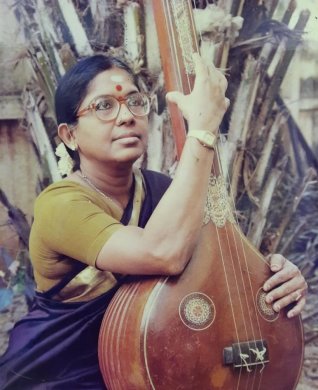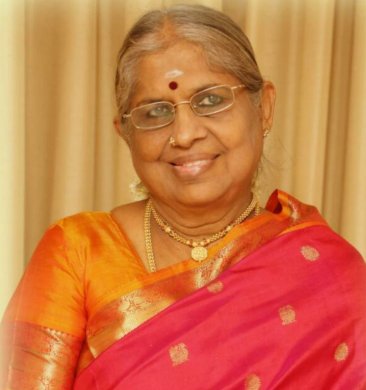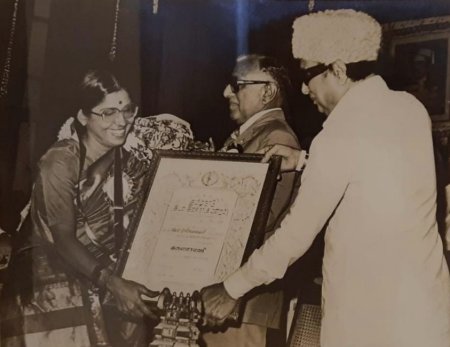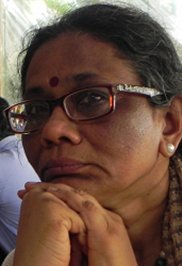
|
 |

|
 |
S. Rajeswari: A satisfying journey in music - Hema Iyer Ramani e-mail: iyerwrites@gmail.com August 29, 2021 “Two roads diverged in a wood , and I- I took the one less travelled by, And, that has made all the difference.” - Robert Frost The story of musician S. Rajeswari who was conferred with the M.S. Subbulakshmi Award by Tamizh Nadu Eyal Isai Nataka Manram earlier this year, is one such story where she had to make her choices when she came to the fork in the road. We decide to travel down in time as she recaptures some of her memories of an exciting career- a mixed bag, with mixed emotions, some beautiful, some sad, but all very important facets and milestones in her career. I talk to her about her fabulous career with highs and lows, twists and turns, but long winding and continuous all the same. Ascending the stage at a very young age, she moved on to find success in the concert-arena singing in many sabhas and the most prestigious being, the four p.m slot at Music Academy. A four year assignment that took her away from Chennai had its impact on her career for she found that the opportunities for prime time slots had dwindled on her return. But the music did not stop, for she continued to work with unstoppable magic all through pursuing what was close to her heart - her music. She talks about her journey and her chance encounter with a dance legend, Kumari Kamala, which brought in a new facet to her singing and soon, she carved a niche for herself, and came to be applauded for her contribution to dance music. She soon was the voice behind several prima-donnas of her time.  When did your journey into music begin and how? I was born in 1946 in Pollachi, as the third daughter to my parents, Subramanian and Savitriammal. I grew up listening to the sound of music. As my older siblings learnt and practiced, I imbibed the notes allowing it to sink into my system unconsciously. My paternal aunt was also trained in music. My parents were great rasikas too and my father had an incredible voice (he was the one who taught me the “math of music” and the understanding of neraval). If I picked up my first lessons from my siblings, it was my father who continued to walk alongside as my strong companion and adviser. He would wake me up at four each morning by splashing some water as was the normal practice in those days (imagine doing that now!) and I would jump up into a state of deliberate wakefulness. Who was your Guru? Oh, I did not study under a single Guru. Like I mentioned earlier, I grew up listening to music that permeated through the home. When I was about four or five, we shifted to Madras. My father worked for P & T, and so, he was transferred to Madras. It turned out to be a blessing. Vidwan Tanjai Balasubramanian became my Guru. But he felt that since I had already picked up my initial lessons of Sarali varisai and Janta varisai from my sisters (who by default became my first teachers!), I could begin from Geetham. Where did you do your formal schooling? I went to Sharada Vidyalaya in T.Nagar. Since I was fond of music, school authorities were quite supportive about my lessons too. So, it was the classes after school that held my attention - music. If there was one subject in which I fared badly, it was Math. That’s quite surprising, isn’t it? There is a lot of “kanakku” (mathematical calculations) in music which you were rather good at? Yes. It is normally understood that Math and Music go along together. My father wanted me to always understand the essence before I could learn it by heart. And, it was he who explained concepts of math in music as he broke it into portions. For instance, for an avartanam, we have 32 swaras. So, he taught me - we have 4 swaras in first speed, 8 in second speed. An avartanam has 32 swaras (8x4). So in second speed, when you double, you get 64. He also taught me how to simplify singing the kalpanaswaram - instead of looking at the whole swara structure from sa to sa, he taught me to break it up into smaller sections like sa to pa, exploring the permutations and combinations of swaras within that range and then move on to the next range of pa to higher sa. He also taught me raga lakshana, teaching me as to which note I should stress to get the essence of the raga. He told me that I should know the meaning of the song before I could sing because I could get bhava in the song only then. So, when was your first performance? When I was seven, I also learnt Tevaram from Dharmapuram Swaminathan. My first stage performance was thanks to Tevaram and also theatre which I was passionate about. I played the roles of Thirugnana Sambandar. Soon, it was Ramnad Krishnan who became my next Guru. Classes with Ramnad sir were something I looked forward to, but the classes were not as frequent as I would have liked. Ramnad sir had a busy schedule and was hopping from one performance to another. In a musician’s career, performance is an important phase and it is also important to acknowledge its importance when the opportunity comes. I was young to understand all this then, but it was something I reflected on in my later years of my own career. Ramnad sir was so busy performing that he could barely have a class in a month. But when he did have, he would spend the entire day at home, where we would break only for food and “a kutti thookam” (siesta) perhaps. I learnt three “kutti keerthanais” every time he came home. But, realizing that he was committed to his career and understanding that I needed guidance at that impressionable age, he advised my father to seek a Guru who could spend much time shaping and honing my skills. And so it was that Ramnad Krishnan had to pass the baton to another Guru. And so, your Guru Balam became stronger and stronger? (She laughs). You could say that! Each one of my Gurus brought in so many dimensions; each became an important facet of my own music. Soon, it was Vidwan Madurai Krishna Iyengar who became my next Guru. He taught me all I needed to know about tala. Both Ramnad sir and Krishna Iyengar were fatherly figures who played a great role in grooming me musically. The exploration of raga alaapanai, techniques are what I learnt under Madurai Krishna Iyengar sir. Because I had good grasping power and memory, he would teach me all the new compositions and so I was like his memory pad. I also was fortunate to train under guru S Rajam. What was your concert experience like? I was invited to perform at several venues in Chennai and across the country. I was also fortunate to have the support of exceptionally good accompanying artistes like Kandadevi Alagiri Sami and Guruvayoor Dorai on mridangam at a young age because they would play for my Guru Krishna Iyengar, and when I had my performance on the following day after Guru’s performance, I would be lucky to have them agree to stay on to accompany me as well. Any memorable incident? Once at a dance concert in Trivandrum, I sang the padavarnam that I had learnt in college , a composition I knew was Swati Tirunal’s and told Guru Kittappa Pillai as such when he told me to announce it as Tanjai composition. But, he said, you just do as I say (Naa solraen, nee sollu, porum), but when the song was over and the announcement done, the people protested and I was asked to apologize publicly for the faux pas. And, for no fault of mine! Tell us about your A.I.R experiences. At the age of 18, I went for a competition in All India Radio, where in the preliminary rounds, I was selected in all three categories - classical, light classical and light. At the national level final too, I got all the three prizes, but because it was going to the same person, they awarded me only for two categories - classical and light classical. A.I.R had a program for isai natakam and I was asked to be a part of almost all the isai natakams like Nauka Charitam, Valli Tirumanam and many others directed by K.C. Thyagarajan.  Tell us about the experiences that you had with Kamala. (In 1967, at the Central Music College - where S. Rajeswari was then a student - veena Vidwan S. Balachander had been conducting a lecture-demonstration. Totally oblivious to everything around her, Rajeswari had been humming along even as she was following the vidwan’s demonstration. A young woman sitting right ahead of her brought her back from her reverie as she turned around to speak to her. It was the legendary Kumari Kamala who was so taken in by Rajeswari’s singing that she insisted that the latter visit her at her home.) Then, as I began singing for Kamala, I realized I had begun a new journey for myself as well- dance music. Since I began with Kamala, my position would change when I moved from central position as concert singer to accompanying artiste when I sang for dancers. There was an understanding we came to, where my freedom of singing was concerned. I had learnt by heart all the compositions that I had to sing for dance without having a paper in hand. This enabled me to interact with the dancer, understand the subtle nuances and bring emotion to my singing by watching the emotion that the dancer was trying to portray. Since I was familiar with the compositions, it was quite sufficient to have just a rehearsal or two to understand the repertoire for each performance. The musician also has to get an understanding of what the dancer is trying to express and this happen only if we are able to look at them while singing. So, naturally, we cannot be looking into our paper! If I sang an extra sangadhi, they would do an extra sanchari and vice versa. It was challenging also because I had to keep up to Kamala’s rendering of ‘Bhaavayami’ for one and a half hours and the singer must have the calibre to sustain that energy too. For instance in Bhavayami, Kamala would explain what the final adavu and mudra of the sequence would look like, and on my part, I would keep singing neraval until the sequence changed. So, there have been times when I have had to sing the same line twenty to twenty five times and still manage to sustain the interest of the audience. I also had to establish certain rules so that there would not be any kind of misunderstanding later on. I made it clear that whichever mode of transport the dancer as main artiste took, I would also be treated on par.
How has it been with other dancers? I have fond memories of singing for many of the productions of Vempati Chinna Satyam. In 1983, the late MGR, the then CM had attended the performance of Vempati Chinna Satyam’s production (Srinivasa Kalyanam), and I was lending my voice. (So taken in was MGR with her voice that he instituted an award for the category of dance musicians and Rajeswari was the first recipient of the Kalaimamani State Award for dance music.)  Receiving award from MGR With Sudharani, my relationship has been always very good and has been a long and memorable one. I have had fond memories of Anita and Pritha, and when we travelled, Anita’s father would insist I travel by the same vehicle he and his wife took and I would regale them with my songs. I have also sung for many other dancers like Jayalakshmi, Alarmel Valli, Sobha Naidu, Meenakshi Sabanayakam (Chittaranjan), Srinidhi Rangarajan (Chidambaram) and many others. Who were your other influences? Though the musical background helped me, I learnt and imbibed a lot watching Gurus like Adyar K. Lakshman, Kittappa Pillai and others. The way they rendered jatis, bringing bhava to each of the lines according to the requirement of dance, the varied tala patterns were what I absorbed as I watched them being part of the ensemble. When I joined the Central College of Carnatic Music, I was once again blessed to learn from stalwarts like T. Brinda, K.V. Narayanaswamy, T.M.Thiagarajan, T.K. Govinda Rao and Sandyavandanam Srinivasa Rao (the then Principal of the college). Tell us about your career in teaching. Initially, I was not keen on taking up a job. Later I found myself applying for the job but I did not receive the call for the interview. As chance would have it, I had attended a concert and an accompanying artiste told me: See you at the interview tomorrow. I replied that I had not got the card and when I went to the office the next day, I found I did not get the card though I was selected because I fell three years short of required age limit, and the Principal said that they could give me an interview card. At the interview panel, which had a four member team, Veena Balachander asked me to convert Mishram to Tisram (Mishratha, tisrapadithi chollungo ma), and the panel was highly impressed that marked my entry into the college as a teaching faculty. Nevertheless, because age was an issue, my file went to the CM and then the Governor before I could be taken in as a special case. Do you have any special memories of reviews of your music? The most cherished responses have been the praise I got from the most celebrated critic Subbudu. (A translation of a review in Tamil for the magazine Idhayam in 1978 --- “I hesitate to categorise Smt.Rajeswari who sang at 1.30 slot as a junior artiste. The voice is reminiscent of a musical instrument. In the Subhapantuvarali that she sang, the cascade of rainbow hued sangatis flowing from her is something many musicians cannot even visualize. I would urge people who rave about a musician like Parveen Sultana to listen to this singer Rajeswari. With adequate support of rasikas and organisers, she will be a shining star in the firmament”.) Manna Srinivasan, another critic says, “Rajeswari’s solo singing is a superb specimen of emotional throb and spontaneity, revealing some new dimension in self expression. Her accompaniment for dance has set new standards contributing to the total experience. Seasoned as well as budding dancers benefit from her singing with enhanced appeal and big boost.” Can you name some of your memorable awards?  Receiving SNA Award From 1993 onwards I have been a top ranking artiste of AIR. Received Kalaimamani award from Government of Tamilnadu Sangeet Natak Akademi award Bharatha Sangita Bhooshana from Sree Bharatalaya Gandharva Nipuna from ABHAI Awards from Krishna Gana Sabha and Bharat Kalachar. Yes, it has been a satisfying journey for me in music, and the journey still continues.  Hema Iyer Ramani is a writer and essayist focusing on travel, culture, art and leisure. She is the author of Soulscapes: Travel and Conversations in India, a nuanced exploration of the physical, emotional and spiritual connections between people and places. A multi-faceted talent, Hema also works alongside her artist-husband V.V. Ramani, collaborating on set and costume design for dance performances, events and weddings. Post your comments Please provide your name and email id when you use the Anonymous / blog profiles to post a comment. All appropriate comments posted with name and email id in the blog will be featured in the site. |